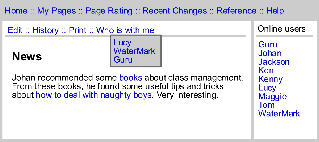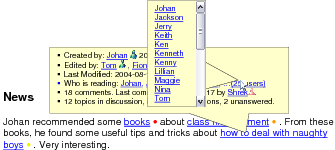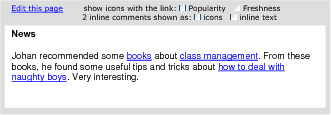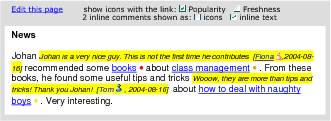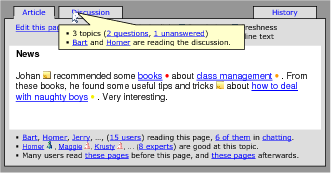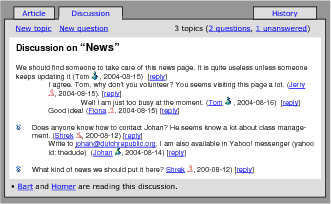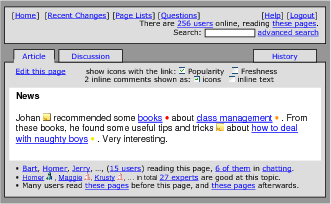FULLTEXT: PDF HTML REFERENCE: BibTeX EndNote DOI: 10.1007/11736639_7
Designing Social Navigation
for a Virtual Community of Practice
2 Open University, 6419 AT Heerlen, The Netherlands
1 Introduction
In companies people meet together during the coffee break. They talk to each other thereby sharing their knowledge, experience and expertise. They are informally bound by what they do together and thus they form an implicit community of practice. The virtual communities of practice are geographically distributed groups of individuals who participate in these activities in virtual spaces. In these communities, no matter physical or virtual, people pay a lot of attention to the behavior of others when they navigate in the space. Social navigation is a way to navigate, mainly considering people, their actions, and the traces left by these actions. It helps not only to locate information quicker, but with increased social awareness, also to motivate people to interact with and learn from each other, especially in distributed communities [1, 2].
The “zij-instromers” in Dutch primary and secondary schools is such a distributed community. The are new teachers, but not yet qualified. They are recruited due to the shortage of teachers, but also required to gain education certification in order to make teaching a career. There are not so many “zij-instromers” in each individual school, but many spread all over the Netherlands. An online virtual community can help them to form a society and to learn from each other. Hence we started a project, aiming at such an online virtual community for these new teachers, believing that social navigation would increase their social awareness and enhance their learning experience.
This paper presents the lessons we learnt from this project. Early in the project, the literature study concluded that we could not completely define the requirements for social navigation unless we put it in a bigger context – a community of practice. After an online questionnaire study on our target user group, we found not only social navigation, but also the virtual community were a new concept for the new teachers. It was difficult to collect the real needs from them. In order to find more requirements from the users’ perspective, a similar user group from an ongoing virtual community was observed. The observation generated more user requirements for both virtual space and social navigation. To get an idea about possible information structures and social navigation approaches, three other virtual community systems, namely wikis, blogs and newsgroups were analyzed and compared. A wiki-like system was mocked up then walked through by experts. The final user requirements combined the results from these studies. At the end of this paper we present some parts of the final prototype, roughly to show how these requirements could be reflected and satisfied at user interface level, followed with discussions.
1.1 Communities of practice
Communities of practice are informal learning environments and have already existed in workplace settings for centuries [3, 1, 4] An example would be a group of maintenance engineers who meet up every day during the coffee break to share tips and ideas. Through these informal meetings, the group shares their combined knowledge, thereby raising the collective competence of the group as whole.
Originally, communities of practice involve people who are close to each other geographically and those who share the same surroundings. The communities of practice can also be distributed since the communication can be performed via electronic media, such telephone, email, and video conference.
As the technology develops, people start interacting in online virtual environments, sharing a web space, subscribing to email lists, discussing in forums and chatting synchronously. Virtual communities of practice are physically distributed groups of individuals who participate in activities, share knowledge and expertise, and function as an interdependent network over an extended period of time, using various technological means to communicate with one another, with the shared goal of furthering their “practice” or doing their work better [5]. In a community of practice, management and participation are important.
Communities of practice develop around things that matter to people [1] and they are fundamentally self-organizing systems. However, lots of virtual communities of practice are lifeless because they fail not only to attract enough participants, but also fail to provide enough support. Communities need to invite the interaction that makes them alive [2]. Appropriate management can seed and nurture the communities of practice [6], by for example providing experts to support distributing quality information, and providing moderators to respond timely to participants – a quick response tells participants that there is always somebody care for them.
Participation in most communities of practice is voluntary. Therefore it is essential to to build up membership and trust [7]. There are two aspects influencing the participation:
Individual Benefits A community of practice thrives because participation has benefits to its members [2]. A community of practice’s life is determined by the value it provides, for example, idea exchange, quality content, expert access, problem solving, competency development, and professional relationships [6, 8, 5].
Social aspects If the users perceive the community of practice as a social space, they will be more motivated to participate. There are there main factors that may influence this perception.
1. Social awareness. Awareness is an understanding of the activities of others, which provides a context for one’s own activity [9]. Social awareness makes people feel that the space is alive and hence more inviting [10].
2. Social interaction. As people gain the social awareness and feel they are within a social space, they interact with others. Social interaction helps people to build trust and relationships among them and hence makes the virtual community more inviting to participate.
3. Social navigation. People navigate following other people, their actions, and the traces left by these actions. Social navigation may also help to locate information quicker and have a better overview of the space [11]. Next we investigate this aspect in more details.
1.2 Social navigation
Social navigation is the “navigation towards a cluster of people or navigation because other people have looked at something” [12]. Social navigation means that, when navigating, people are guided and informed by others and their actions. Social navigation is very common in real environments because people typically pay a lot of attention to the behavior of others and influenced by their activities.
The aim of social navigation of a system is to exploit the behaviors of others for supporting users navigate the information space. However, it should be addressed that social navigation should only guide and influence, but should not control people’s action and decision [10].
Social navigation can be “direct” or “indirect” [13]. In direct social navigation, people directly give advices and guide each other, synchronously or asynchronously. In indirect social navigation, people use navigation cues to be aware of other people’s actions or the traces of these actions. An example of the indirect social navigation can be found in the EDUCO [14], where the color of a document icon indicates the amount of the reading activity on the document.
Social navigation can also be “intended” or “unintended” [15]. In the physical world, an example of intended social navigation would be people explicitly recommend someone a place to visit, where an unintended example would be footprints on the snow that people might follow. In a virtual space, an unintended example can be that a user leaves traces, or hints, to other users without doing this in purpose.
Systems may facilitate social navigation in many different ways, for example:
Interaction history can be preserved, integrated and displayed to users. The users can use this history to guide themselves navigating in the information space. For example, in wikis, “Recent Changes” aggregates the most recently changed pages and “View other Revisions” preserves different versions of the pages. Read-wear is another type of history enriched navigation which aggregates activities on certain objects. People can see how an object has been used (e.g. read, changed and downloaded) by others. For example in Dieberger’s CoWeb [16], small footprints with different colors are used to represent the amount of traffic behind a page.
Recommendations can be made explicitly based on recorded information. Rating and commenting are common and simple methods. For example amazon.com accumulates purchasing activity and gives recommendation such as the items that “Customers interested in this title may also interested in”
Synchronous communication imitates face to face communication in real world. It can be also found in EDUCO [14], where online users are presented in the document space as moving dots around documents, indicating the users who are currently reading a document. Real-time communication can be then initiated by clicking on one of the dots.
Social navigation depends very much on the information structure of the community [17]. A virtual community of practice can be formed with different communication tools, such as bulletin boards, chat rooms, and email lists. These tools determines which social navigation approaches can be used. The activities that people are performing or have performed are the basic sources for indirect social navigation. In amazon.com web site, the structure supports people to buy books and add reviews online, therefore it is possible to use the information of “Customers …may also interested in” and “Customer reviews” as social navigation approaches.
Based on these understandings, we could not simply peel social navigation from a certain virtual community of practice. Instead, an integrated approach should be used and the social navigation requirements had to be defined in the context of a given virtual community. But first of all, we needed to have a closer look at our target user group.
2 Target user group
After the basic understanding of social navigation and communities of practice, we were ready to find out what our target users would think about the idea. Were they experienced with the virtual community of practice and what would they like to benefit from the new system? In an idea situation, experienced users would tell what they wanted from the new system, and how they would like to take advantage of the social navigation. However, were they experienced?
In order to know our users better, we developed a questionnaire [18]. Since the users were spread all over the Netherlands and hard to reach, we launched the questionnaire online. Thirteen were invited and responded.
2.1 User profile
They were new teachers from Dutch primary and secondary schools and they wanted to make teaching a career. They aged between 20 and 35. Although they had required domain specific background, such as mathematics and physics, they were different from other teachers because they were not yet qualified. The reason of involve them in teaching was the shortage of teachers in the Netherlands. Most of them did not have any teaching experience.
They used computers about 2 hours a day at school or at home. They often used Microsoft Word for writing and Microsoft Outlook for emailing. Only few of them also had some experience with online forums and instant messaging. Their computer skills and the usage were found to be very limited.
During the working days at the primary or secondary school, they consult other qualified teachers. They had to go to training centers one or two days a week, where they exchanged information with other teachers and consulted their mentors. They also communicated with each other over the phone and sometimes using email.
2.2 Most wanted benefits
In the questionnaire, we also provided a list of possible benefits that a virtual community system might offer and let the participants decide whether these benefits were important for them. The following benefits were thought important by most of the participants:
1. providing efficient idea exchange;
2. providing high quality content;
3. helping for problem solving;
4. helping people do their jobs;
5. developing individual skills;
6. providing access to experts.
The following items were considered less important by most of the participants:
1. motivating people to learn;
2. providing challenges and opportunities;
3. developing professional relationship.
The validity of user requirement gathered from the online survey was low. The main reason was that the target user group was new to the concept of the virtual community of practice . It was found to be difficult for them to imagine something they had never experienced. We could hardly collect any requirements on social navigation either. We could, for instance, have let them practice an online system. However, most of them hesitated to try anything new due to their limited computer and internet knowledge. To compensate, we turned our eyes on an ongoing virtual community to observe and study an experienced yet similar user group.
3 Teacher Focus
Since our target user group was not experienced with the idea of virtual communities of practice, we decided to have a closer look at a similar user group of an ongoing online community called “Teacher Focus” (teacherfocus.com). They had similar profile not only because both were teachers, but Teacher Focus also tried to involve new teachers in a dedicated space. By November 20, 2005, they had 3897 registered users and 20774 posted articles. This enabled us to observe a much bigger group of users, on their behaviors and the content of the postings.
Forums were the major parts of the service which were categorized into several topics, such as New Teachers’ Place and Educational Technology. New Teacher’s Place was the most popular forum. The users of this forum have the similar user profile to our target users. The forum had the same goal with our future system – for new teachers to look for help and advices, and to share their teaching experiences.
3.1 New Teachers’ Place
We decided to analyze the users who posted to this forum during May 2002 and May 2003. The reason for choosing this period was that it was the most active period. Most of the users posted more than one post. The rate of reply (84%) during this period was higher than average (75%). There were 55 users posted 82 articles. 10% of the articles were posted by moderators and the administrator. 80% of the posts were questions. 84% of the posts had replies and there were 187 replies in total, in which 60% were replied by the moderators. 60% of the question posts got no reply. There were about 4000 views in total. During this one year period, 80% of users posted just once or twice, only 10% of the users posted more than ten times. In general, comparing to the average of all other forums, users in this forum were much move active, especially in asking questions and joining in discussions.
3.2 Social navigation
A few social navigation cues were used:
Interaction history Thread lists showed the author of the original post, number of the replies and views, creation date of the first post, and the latest reply as well as the author of the latest reply. People could be guided by these data, for example, they might know the authors and always be interested in their posts; the number of the replies and the views showed the popularity of a certain topic.
Intended social navigation In the forums, people posted questions to ask for help. Often, people redirected the discussion to another forum, thread or post with a link. Sometimes, the users were asked to read instruction articles so that they could post their questions at right places and in right ways, which was a typical kind of intended but indirect social navigation.
3.3 Wanted benefits updated
Besides the observation, we also sent our online questionnaire to selected Teacher Focus users especially those who posted to New Teacher’s Place. 20 replies collected. Analysis showed the user group had indeed similar profile, however the selection of wanted benefits differed. The 3 excluded benefits by our target user group (see section 2.2 ) were also thought important by Teacher Focus users.
Our target users could not foresee these features without actually experiencing a virtual community such as the Teacher Focus uses did and this explained why these important benefits were not “wanted” by our target user group.
3.4 Other observations
Most of new teachers came to the forums for solving their problems and looking for help. Before any new teachers started to contribute, they had to be convinced that this was the right place to do so. So the further system should not start from an empty skeleton.
Experts and experienced teachers should stay in the community to provide well organized and useful information, solving problems and sharing practical experience, so that the new teachers could benefit more than only new teachers involved. So the target system, should not only focus on the new teachers, but also involve and attract experts and experienced teachers.
As the new teachers participated, they started to develop their own personal contacts with people in the virtual community. People tended to have private person to person conversations. Teacher focus did not provide private spaces for such person to person conversations. Such conversations were found to be enjoyable for the users involved, but at the same time, to be annoying for other users because often these conversations were also full of gossip and jokes.
The social navigation cues found in Teacher Focus should be kept for our purpose, such as number of the replies, number of the hits, the time and the author of the first and the last post. Intended social navigation should be encouraged in the future system.
People also would like to know and to follow what their friends were doing. A list of online friends and their current activities would have increased the feeling of social involvement in Teacher Focus.
The validity of user requirement gathered by observing the similar user group in the ongoing community was higher. There were three reasons. First, we were observing the users that had already some experience with virtual communities of practice; second, the existing content of the online community gave us opportunity to analyze how a new teacher could benefit from others, especially the experts and the experienced teachers. Third, it also enabled us to do some quantitative and thus more objective analysis.
However so far we only looked at one of the online forums. There were more types of virtual communities than those of forums. Next, we studied three different online communities in order to get a bird’s eye view.
4 Virtual community systems
We investigated other three virtual communities of practice: wikis, weblogs, and newsgroups.
4.1 Wikis
A wiki is a is a group of Web pages that allows users to add content, as on an Internet forum, but also permits others (often completely unrestricted) to edit the content; A wiki is to support collaborative writing and to open discussions. From management point of view, most of wikis are self-evolving and self-maintained. Some wikis support authorization to protect pages from the abuse. However, it is approved that there is hardly any inappropriate posting. People are given rights to create, edit and remove pages; it is just too easy to mess it up and hence there is no challenge whatsoever to hack around. Everybody who uses the wiki feels responsible to keep the wiki clean.
The original wiki has mainly two social navigation tools: one is “Recent Changes” which aggregates the most recently changed pages; another is “View other Revisions” which preserve the different versions of the pages. People can trace the history of the pages.
4.2 Blogs
A weblog, or simply a blog, is a web site which contains periodic, reverse chronologically ordered posts on a common web page. Such a web site would typically be accessible to any Internet user. Individual posts either share a particular theme, or a single or small group of authors. The format of weblogs varies, from simple bullet lists of hyperlinks, to article summaries with user-provided comments and ratings.
Two features which are common to blogging are “blogrolls” and “commenting” or “feedback”. A blogroll is a list of other blogs, with which a blogger creates a context for his blog. This is a typical cue of intended social navigation. Blogs also often allows users to post their own comments on an article.
4.3 Newsgroups
A newsgroup is a repository, usually within the Usenet system, for messages posted from many users at different locations. The Usenet is one of the oldest computer network communications systems still in widespread use. It is completely decentralized by categories, then interest groups, then a specific topic or subject area. Newsgroups can also be considered as the virtual place where people exchange ideas, discuss, communicate and even make friends [19].
A typical social navigation cue in newsgroups is the FAQ’s (Frequently Asked Questions). If many people keep asking the same question, the question together with the answers are archived and categorized into the FAQ area. This is typical intended and indirect social navigation.
4.4 Comparison
The above three systems have similar yet different usages in information sharing. Wikis focus on the collaborative editing; blogs focus on individual publishing and feedback gathering; newsgroups focus on asynchronous discussion.
Wikis provide information resources in a more collaborative and structured way. The open way of page creation and editing may also provide challenges and opportunities for the users to contribute. Newsgroups allow open discussions and the users often post their questions and ask for help. It has a larger coverage of the experts that are willing to answer these questions. Comparing to wikis, It is harder to find information in newsgroups. Reading a blog can also help to solve problems if the blog is about a particular topic, provided that people know where to find such a blog at the first place.
It seemed that there were more social navigation approaches in wikis and newsgroups than in blogs. The wikis appeared closer to what we wanted, providing with some additional features, for example, the commenting mechanism from the blogs and asynchronous communication from the newsgroups, would also make our target system richer.
5 Mockup and feedback
Since we felt that wikis were closer to what we wanted, we decided to use Flash to mock up a wiki, integrated with the user requirements found on social navigation and the features we thought could be helpful in social navigation. We presented this prototype to a committee for expert walk-through. The committee consisted of a educationist from the project owner, a professor from the field of communities of practice, and three trainers from teacher training centers. Most of them knew the target user group very well, so the feedback from them should be valuable for our target user group.
5.1 Social navigation
Social navigation approaches included in the first prototype (Fig. 1 ) were :
Page rating The popularity of a page indicated the traffic, and the freshness shows how long ago that page was last modified . The users could sort the page list by either the popularity or the freshness of the pages.
Recent changes It provided a summery of recent changes on the content. Users could choose to show a list of “Recent changes”, “changes in last 3 days”, “changes in last 7 days” or “changes in last 30 days”.
Online users It showed a list of online users with their personal information. It gave the users certain degree of social awareness – the user was not alone in this community. In many wikis, the personal information was shown as a page when a user name was clicked. We thought it might be disturbing if the user was distracted away from the content. We chose to show this information within a callout window when the mouse cursor was hovering over the user name.
Who is with me It showed who else was reading the same page and their personal information if available. It might result in direct social navigation if one would like to chat with others about the page that they were reading.
My pages It presented a list of the pages that was created or edited by current user, with their popularity and freshness. This function was not a common feature in most wikis, but it provided the traces that the users themselves left. This could give the users a feeling of contribution and achievement, which we thought would encourage them to contribute more.
History It showed a list of different versions of the current page with version numbers, editors and their personal information if available. An icon would also be shown together with the editor’s name indicating the online status.
Online chatting The system also provided online chatting. The user could chat with many others in a public chatting room about the page that they are reading together, and start a private conversation in a separated in a private room.
5.2 Feedback
This mockup prototype was walked through together with the committee. Feedbacks were for example:
– Comments should be at multiple levels. Comments should be able to be associated with not only an article, but also a part of the article, for example a sentence or a paragraph.
– “Who is with me” should be more user friendly. The users should be able to see who are on the same page immediately without any clicking.
– Social navigation should not be only at the top level, but also in a local context. More social navigation cues should be available at the level of internal pages, such as users on the same page, experts good at the topic, and comments and questions about this page. The system should also show the users that were close, for example, the users who were in the same category, and the users who were reading a page that this page had a link to or was linked from.
We tried to collect more feedback from the expert walk-through by presenting them improved versions according to the feedback from the previous round. This mockup and feedback process was iterated for several round until the experts were satisfied with the prototype. A part of the final prototype is presented in section 7 .
6 Final requirements
The final requirements contained 60 categorized items, including the benefits that should be provided by the community of practice, the ways to achieve these benefits, the information structure of the content and the social navigation approaches. Detailed requirements are listed in [18]. Here we list few requirements on the information structure and social navigation.
6.1 The basic structure
As the basic structure, the target system should include at least the following four components:
Pages Pages are the basic components as those in wikis. People should be free to create and modify the pages and hence every page may have many versions. The internal pages are where people collaboratively create content, share their knowledge and information. The overall content structure of the system should be maintained by the users themselves. The users may create special category pages and link other content pages to the category pages. The system should also allow the users to evaluate how interesting a page is.
Inline comments The system should support commenting in the lines of the internal pages, on an internal page as whole, or a part of the content. People may hesitate to modify the content created by others, but may like to add inline comments to the content to show their respects to the author. This is common in contemporary word processing software, but not often seen in most of the wikis. With inline comments the amount of the version history can be reduced to a minimum, otherwise the history version list might become too long to be useful. Comments on pages are often not perceived as a change to the content and thus should not be recorded in the version history unless the associated part of the content is changed.
Discussions Discussions are comments on the content at the page level, but also engage the uses into asynchronous discussion. The discussion on a page should be organized into topics and replies as it is done in the newsgroups. This is also where a user can ask questions. A question is a special topic that marked by the user requesting for answers from the others. Because these topics are marked, it is possible for the system to collect the questions, especially unanswered questions from a page and from all the pages as well.
Chat rooms Every page should be associated with a chat room, where the users may join to talk about the page as the topic. There should also be chat rooms which are not associated with any page where the user may decide the topics. The user should also be able to start a private chat room that only invited users may join. These chat rooms should be categorized so that the user can easily find one. Unlike discussions, conversations in the chat rooms should be real-time, and the conversations should not be stored.
6.2 social navigation
Social navigation should be organized according to the activities around the basic structure components.Around pages, the social navigation cues can be the number of visits, recent changes, page ratings, “who is with me”, and the pages most of others visited before and after this page. Around inline comments, the cues can be recent commented pages and number of the comments. Around discussions, the cues can be recent discussed pages, numbers of topics, answered and unanswered question, and recent questions. Around chat rooms, the cues can be most active rooms, and numbers of the users in a chat room etc. The users often like to follow certain people with whom they share common concerns and interests. The contributions from these people could be more useful than those from others, and should be implemented as social navigation cues as well.
7 Final prototype
In this section we show some parts of the final prototype and give some examples how the requirements can be satisfied at a user interface level. The social navigation approaches are mainly the history and read-wear information of a page. There are mainly two considerations when we decide which cues should be used:
– Many kinds of read-wear information give different social navigation cues. These cues can be represented with small icons so that we can show as many as possible. Wherever a link to the page is presented, these small icons follow right after. However, the link is often added to a word or a sentence, too many icons in the text will decrease the readability.
– Many social navigation cues are information collected from the activities system-wise. Therefore most of these cues can be shown as a list in a separated page or as a pull down menu. Buttons or links could be used to activate these pages or menus. But as mentioned in the feedback from the expert walk-through, the user should see the social navigation cues directly and it should not require extra effort to activate the presentation of these cues.
These two considerations seem contradictory. We have to either trade the readability for the space to show more cues, or vice visa. We cannot overcome this problem unless we try to optimize the tradeoff – a typical challenge in design.
In a page, we decided to only present the local social cues that are most often used directly along with the links to the page. The rest of the cues about the linked page will be shown in callout windows. Callout windows are the windows that pop up when the mouse cursor hovers over the link. The same strategy will be used for the links in a callout window. That means extra social navigation cues will be available only when the user needs it. The use of “Hovering for a callout window” instead of “clicking for a popup window” requires less mouse clicks and hence less user effort for social navigation.
The global social navigation cues are independent of a specific page; hence it is not logical to show them inside a page. Most of the global social navigation cues require a list, often a long list, to present. Direct listing together with an internal page would squeeze the space for reading and editing. So we decide to use links or buttons for activating the lists. We should show briefs of these global lists directly whenever is possible, for example, the number of the online users, the number of the users who are on the same page. More details can be shown in callout windows when the user moves the cursor over the brief. Clicking on these briefs would activate the page showing relevant list with all details.
7.1 Social navigation cues inside a page
As said, in order to ensure the readability, we only want to show the icons of the most often used social cues inside a page for social navigation. We do not know yet which social cues are the most often used ones. This needs a design process to make the choice, or we may leave this to the users – they decide which cue icons should be shown along with links according to their personal preference. As an example, we assume that the popularity is a right choice. In fig. 2 different colored dots indicate the different level of popularity of the linked page. Red dots appear “hot” and indicate the very popular pages. The color turns orange, and then yellow when there is less traffic to the page. Once the mouse cursor is over the link, a callout window shows additional social cues, such as the author of the page, who else edited, the date of creation and the last modification, online status of the authors, and who else are reading the page. When the user moves the cursor away from the link the callout window disappears immediately. Hovering the cursor over a particular user name will pop up a callout window shows the contact information, expertise and a brief about the contributions from this user. A chat may also initiated from this callout window.
Too many overlapped or nested callouts might also cause usability problems. We have to find proper tradeoff between the direct shown social cues and the callouts. We may leave this to the user; the user decides which ones should be shown inline with the page, to what extent they should be shown, or not to show them at all to gain maximum readability. In fig. 3(a) , the user decides not to show any of the social cues and leave all of them to callout windows.
When there are any inline comments, the user many decide to show them as icons and use callout windows to show the details (fig. 3(b) ), or to expand all the comments as in line text if the use does not mind readability (fig. 3(c) ), or to show none of them. As we can see from these figures, there is always a tradeoff between the amount of the social navigation cues direct shown in the page and the readability of a page. This holds not only for the cues inside a page, but also for the cues of a page, and the global social navigation cues as well.
7.2 Social navigation cues of a page
From the data structure point of view, a page is an article associated with 3 other elements: the discussion on the article, the revision history and an online chat room. We may leave the online chatting function to another dedicated system, for example, an IRC (Internet Relay Chatting) service. We associate the page with a unique chat room from the service, for example, “ThePageTitle@OurSystem.com”, so that we can leave the complexity of chatting service out and only provide a link to this chat room in the page. We might need a list of the users who are currently in the chat room, which can be done with a simple query to the chat room using the IRC protocol. Now that the chat room is left out, we only need to take care of the discussion and the history. We organize them into tabbed sub pages (fig. 4 ).
We show the brief of the social navigation cues about the current page at the bottom of the page. When the article is long and it requires scrolling, we suggest keeping the brief always visible when the brief does not require too much screen space so that the social navigation cues can be reached at the first glance or within one click. Moving the mouse over the links in the brief, the user will see more details about the social navigation cue. For example, when the cursor is over “chatting”, a callout window will show an introduction to the chat room and who are in the chat room, whereas clicking on “chatting” will lead the user directly to the chat room. The user may also hover the cursor over the tab titles of other two associated elements to see the briefs of them. In fig. 4(a) , a callout window shows the brief of the discussion.
The user may click on the tab titles to enable the tabbed element. In fig. 4(b) , the Discussion tab is enabled. The user may click on “New topic” to start a new thread, or on “New question” to start the new thread with a question. A question is just a kind of special topic that initiated with the “new question” link and marked with a question mark, otherwise there is no difference. It is expected to be useful, especially for the new teachers, to post their questions asking for help. On the top it also shows a brief of the discussion: how many topics there are in total, including how many questions, and how many of them remain unanswered.
Again at the bottom of the page it shows the social navigation cues. There are not so many cues about this discussion, so we list all of them: Bart and Homer are reading this discussion.
As shown in fig. 4(b) , the discussion is organized in a typical newsgroup manner: topics are sorted according to the date, and replies are nested into a tree like structure. The operations on the topics and replies are almost the same as those in the newsgroups. We expect this will bring some of the advantages from the newsgroups into our wiki-like design.
7.3 Global social navigation cues
We show global social navigation cues on the top of every page together with other navigation tools (fig. 5 ). The designers may decide whether to put it on top or at the left or right side. But no matter where to put them, there are always more navigation means than the global navigation panel can display. As many web designers do, we use nested popup menus and callout windows to save the space.
We need a line to show a short sentence about how many users are online. Moving the mouse over the number of the online users will pop up a callout window showing a list of all online users. When the cursor is over “these pages”, another callout window shows a list of the pages being read by the online users, sorted by the number of the users on each page.
When the curser hovers over “Page Lists”, a menu pops up shows all kinds of ways of page listing, many of which contain different social navigation cues. When the curser is over “Questions”, we show a list of the unanswered questions collected from all the discussions in a callout window, sorted by the date. Again, there may be more questions than we can show in a callout window. To counter this problem, we may use a scroll bar, or list only part of them and present a link to all of them.
Although many requirements are covered in the prototype presented here, we do not try to present a complete design and cover all the user requirements, instead, we take some of them as examples. Moreover, we only touched the social navigation part of the internal pages. We did not cover other navigation means, for example, content structure based navigation – how to categorized the content, how to present the categories and how to navigate these categories.
8 Discussion and conclusion
The aim of the project was to define the user requirements of social navigation in a community of practice. It was quite clear, but challenges appeared during the project: at the beginning, we did not have an idea what our target system – the community of practice would look like. Without a given navigation space, there was no way to find out how to navigate it. It was also very difficult to reach the target user group. The concept of virtual communities of practice was new to our target user group. Most of them did not have any experience with any kind of virtual communities of practice. It was hard for end users to imagine what they wanted and how they would like to do it in a never experienced virtual space, although everybody had social navigation experience in real environments.
We managed the challenges by introducing different approaches step by step, from theoretical studies, online questionnaires, observations on an existing virtual society, analysis on similar systems, to prototyping and expert walk-through. During this process, we always first looked at the community of practice, and then tried to find out which social navigation approaches were available in the community, and which ones could be used in our future system. The user requirements gathered from above mentioned methods have different levels of validity: the results form the end users with the online questionnaire provided primary, important but insufficient information; observation and analysis on a similar online virtual community that had a user group with similar profile, provided more accurate requirements; comparisons between similar systems made it possible to make our minds about the structure of the content and the system. Finally the prototyping iteration with the expert walk-through consolidated the findings.
Currently these requirements together with the final prototype are taken into account for implementation. We are confident that the requirements and the design reflect enough the real user needs, in terms of social navigation for the new teachers to get into the world of virtual community of practice.
References
1. Wenger, E.: Communities of practice learning as a social system. System Thinker 9(5) (1998)
2. Wenger, E., McDermott, R., Snyder, W.: Cultivating Communities of Practice. 1st edition edn. Harvard Business School Press (2002)
3. Lave, J., Wenger, E.: Situated Learning: Legitimate Peripheral Participation. Cambridge University Press (1991)
4. Wenger, E., Snyder, M.: Communities of practice: The organizational frontier. Harvard Business Review 78(1) (2000) 139–145
5. Allen, S., Ure, D., Evans, S.: Virtual Communities of Practice as Learning Networks. Instructional Psychology and Technology Program, Brigham Yong University (2003)
6. Wenger, E.: Communities of practice: Learning, Meaning, and Identity. Cambridge University Press (1998)
7. Kimble, C., Hildreth, P., Wright, P. In: Communities of practice: Going Virtual. Idea Group Inc. (2001) 220–234
8. Millen, D., Fontaine, M., Muller, M.: Understanding the benefit and costs of communities of practice. Communications of the ACM 45(4) (2002) 69–73
9. Dourish, P., Bellotti, V.: Awareness and coordination in shared workspaces. In: the 1992 ACM conference on Computer-supported cooperative work, ACM Press (1992) 107–114
10. Dieberger, A., Dourish, P., Hook, K., Resnick, P., Wexelblat, A.: Social navigation: techniques for building more usable systems. interactions 7(6) (2000) 36–45
11. Lonnqvist, P., Dieberger, A., Hook, K., Dahlback, N.: Usability studies of a socially enhanced web server. In: CHI 2000 Workshop on Social Navigation. (2000)
12. Dourish, P., Chalmers, M.: Running out of space: Models of information navigation. In: HCI’94. (1994)
13. Dieberger, A., Hook, K., Svensson, M., Lonnqvist, P.: Social navigation research agenda. In: CHI ’01 extended abstracts on Human factors in computing systems, ACM Press (2001) 107–108
14. Kurhila, J., Miettinen, M., Nokelainen, P., TIrri, H.: Educo - a collaborative learning environment using social navigation. In de Bra, P., Brusilovsky, P., Conejo, eds.: Adaptive Hypermedia and Adaptive Web-Based Systems(AH 2002), Springer (2002) 242–252
15. Forsberg, M.: A Collaborative Building for Pharmaceutical Use. Master thesis, Linkoping Institute of Technology (1998)
16. Dieberger, A.: A sonification enhanced navigation tool for history-enriched information spaces. In: ICAD’2000 (International Conference on Auditory Displays). (2000) 172–176
17. Robins, J.: Affording a place: the role of persistent structures in social navigation. Information Research 7(3) (2002)
18. Xu, W.: Requirement definition of social navigation in a virtual community of practice. Thesis for professional doctorate in engineering, Eindhoven University of Technology (2004)
19. Roberts, T.: Are newsgroups virtual communities? In: the SIGCHI conference on Human factors in computing systems, ACM Press/Addison-Wesley Publishing Co. (1998) 360–367
